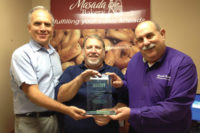‘Going from good to great’ is a pervasive theme at Phoenix-based Capistrano’s Bakery. So is the phrase, ‘It Can Be Done.’ This rather quiet, wholesale artisan baker
| Want more Capistrano's Bakery? |
| Want to see more images from Capistrano's Bakery? Click here to see the full gallery! |
| SFWB Visited the Capistrano's Bakery! Check out the video by clicking here! |
| Want to read more about Capistrano's Bakery? Take a look at the SFWB plant feautre by clicking here! |
works hard to ensure that its products are tasty, innovative and what its customers want. That’s one of the reasons why it’s our 2014 Bakery of the Year.
Friendly people, efficient, friendly service and, above all, great-tasting bread and rolls are what Capistrano’s Bakery is all about. The Phoenix-based wholesale bakery crafts a variety of breads, buns, rolls, bagels, pizza dough, natural sourdough bread, pretzel rolls and artisan and specialty products, with more than 200 items from which to choose. Delivering its products fresh daily, Capistrano’s works tirelessly to give its foodservice customers and those for which it copacks a quality product. It also helps its customers develop signature bakery items to make sure they have just the right product to complement their menus.
Yes, Capistrano’s Bakery is a regional player. It distributes its product primarily to foodservice customers throughout Arizona, and as far as the West Coast. Some items are shipped frozen to parts of the Midwest, and the company hopes the frozen product business increases. “Predominantly, though, we’re a fresh baker,” says Allen Herman, Capistrano’s operations team leader.
Now its winning corporate, internal and external marketing strategies are taking Capistrano’s to the next level. It’s for these and other reasons uncovered here that Capistrano’s is Snack Food & Wholesale Bakery’s 2014 Bakery of the Year.
“At Capistrano’s, we have one basic philosophy,” explains Herman. “We can’t stay successful without our customers being successful. Our future success depends on that, and our ability to clearly understand the needs of our customers. We want to be known for outstanding products and exceptional customer service. So it’s nice to get recognized. The Bakery of the Year award is a wonderful distinction. We’re thrilled to get it.”
Revamped operation
Yes, Capistrano’s is relatively small. The nearly 40-year-old bakery is also bringing its operation to the next level. About half of its business is in its ample bread product line, and the other half is in rolls, which includes specialty rolls and artisan products.
Originally working out of two area locations (Capistrano’s Bakery and Homestyle Breads), the company consolidated in 2012 into one roomier location, just south of the Phoenix Sky Harbor Airport. Capistrano’s completely renovated the space to suit its needs, and installed four production lines that feature new and updated, automatic equipment, including a complex network of cooling conveyors, a large, walk-in proof box that holds 60 racks of bread, eight rack ovens, one deck oven, two metal detectors, a speedy automatic bread bagger, an intermediate proofer, and a showpiece, multizone traveling 38-tray oven that was revamped and redesigned with 2014 technology. This was done at less than half the cost of a new oven, thanks to assistance from Banner-Day, Saginaw, MI.
The bakery’s “new” building was a former marble quarry counter-top production house, so the renovations began in 2011 and were complete in 2012. “We brought everything here from the former two locations,” Herman recalls. There are now two main production lines for bread and rolls and two lines for artisan and specialty products, like specialty breadsticks, sourdough, rustic Julien Demi Baguettes, rosemary dinner rolls, batards, focaccia and breakfast breads, such as apple Danish loaf and cinnamon raisin.
On the day of SF&WB’s visit, the makeup lines were making Jewish-style marble rye, cinnamon raisin bread in a 1-lb. loaf and a 2-lb. Italian loaf. “We have three starters that we store in tub containers in the mixing area,” Herman says. “We have maintained these starters for some time, and brought them over from the other facilities. Some of them are years old. We use poolish and natural sours as well. We bake hearth-style, or what we like to call home-style products, fresh daily and deliver them using our six delivery trucks. Some of the products are signature items developed specifically for customers.”
No GMOs are used. “We have never used them,” Herman mentions. “But we do use a lot of seeds and streusel, raisins, fruit and flavored flakes, and are looking at some new flavors for our line of breakfast breads, like Orange Vanilla. We’re also tinkering with Tomato Basil.”
Customers have also been asking Capistrano’s for a really outrageous sourdough bread, Herman says. “We’re working on that, too,” he explains. “We have a flavor mission and believe that taste is the most important thing we can offer. We don’t want to be a commodity—we want each product to stand out, so we’re upgrading many recipe profiles and flavors to stand out even more.”
Moving to a facility with more space and room to grow was a wise decision, affirms Jason Link, chief engineer. Demand was growing, and the bakery didn’t have enough capacity at each of the two small locations to keep up as well as it would have liked. The former baking areas were crowded, which became a big issue.
“The move here has significantly boosted throughput and efficiencies,” Link says. “It’s allowing us to become more sophisticated and more automated. We now have more advanced systems to make us faster, more consistent and more productive. When we moved here, we were able to triple our line speeds almost right away.”
A big issue was trying to output more product in too cramped a space, says Herman. “Here, we have much more production space—nearly 40,000 sq. ft.—where the two small facilities were 12,000 and 13,000 sq. ft., and some of that was for offices.”
Upgraded oven
The other issue was Capistrano’s need for a larger-capacity bread and roll oven. Such a large oven was not feasible for either of the previous locations, so before the move, Link did some research and conducted a survey of available ovens throughout the area, analyzing costs of new versus existing systems. With determination and plenty of investigative work, Link found an oven that might work. “We tracked down a used traveling-tray oven for sale in California that dated back to the 1960s,” he says. It turns out that the old oven was really a diamond in the rough. “It was well-built and workable,” he says. “So we had it moved here.”
Other equipment was also added to create four makeup lines for the new location. Link also designed a network of overhead tri-level “racetrack” cooling conveyors that save space and provide all of the time the bread needs to come into its own.
Link discovered that Banner-Day had originally installed some components in the used oven, and contacted the company to work on a gameplan to significantly upgrade the large system and its original controls.
According to Joseph Day, CEO of Banner-Day, “the oven’s basic structural ‘bones’ were sound, so the oven was moved to the new Capistrano’s facility and reassembled as-is. But [installing the new technology in it] presented some challenges and opportunities in order to realize its full potential in a modern, high-production bakery like Capistrano’s.”
One of the new features Banner-Day installed was its Power Interruption Protection (PIP) system, used in conjunction with its automatic ignition sensor, or direct spark ignition system (DSI). DSI allows direct-fired oven burners to automatically re-light without the need to re-purge the oven in the event of a brief electrical power interruption. This helps the bakery avoid significant downtime and consequently reduces downtime costs and lost product.
At the core of an oven’s operation and performance, the DSI is a solid-state device that provides a dedicated ignition source and the spark for ignition as well as a safety feature of modern flame supervision. In order to deliver maximum flexibility and safety under a variety of baking conditions, one of these DSI modules is used for each burner. (For more details, see SF&WB’s Plant Story on Capistrano’s in this issue.)
Banner-Day made it easier to get a used oven because of its history of expertise and its familiarity with the particular model. Several oven components and the controls were fine-tuned and/or replaced, so the bakery now has the performance of a new oven at less than half the cost. This was critical for a bakery working with a limited capital budget, Herman says. “We had to keep our equipment costs in check, but we still needed an oven that could electronically and safely function in the 21st century,” he explains. “We like to find used equipment that can be cost-effectively upgraded to produce amazing results.”
“The framework of the big revolving-tray oven and a large proof box were the first items to be assembled in the renovated space,” Link remembers. “All of the lines were installed in stages. We put in the roll line while the big oven was being built. The oven’s framework was installed, and then we put in a large proof box. Then, while building the rest of the oven, Banner-Day put in a whole new control panel system and the electronics. That’s when we constructed the racetrack [cooling] conveyor. It was quite a project, after we got all of the equipment here, to set it all up.”
Herman adds that Link designed the line layouts to conveniently fit the new space. “He did an outstanding job,” Herman says. “We put in some new and some refurbished equipment and engaged a general contractor for the building, but Jason worked directly with all of the [renovation] groups and the design engineers. He was able to put all of the pieces together to make everything happen. It was great to repurpose a piece of equipment like this oven, which was still very functional and made well, and now fits in well in our sustainability program.”
Rapping about inspections
The break room just off the plant floor is newly furnished, and features a large collage on one wall that represents one of the bakery’s messages: “We don’t have to look alike to be a winning team,” Herman says. The company created the artwork for its employees. “We also regularly have what we call ‘rap’ sessions with our associates,” he continues. “During our latest session, we thanked everyone here for how well they did on a recent inspection by the Food and Drug Administration (FDA).”
A rigorous process, the inspection was very involved and comprehensive. “Everything was checked, and it’s quite thorough,” Herman says. “For one, you don’t know when the FDA will show up. We do get audited annually by the American Institute of Baking (AIB) International, and receive a Superior rating, so we were really pleased when we got a great review from the FDA. During our rap session, we all talked about how we did, what we did and how we expect to keep on doing that well. We keep everything as clean as humanly possible.”
A food-safety plan was already in place by the time the bakery relocated, and it has prepared for the Food Safety Modernization Act (FSMA) changes, Herman says. “We have a professional food-safety coordinator on staff, Juan Martinez, who puts together our food-safety programs and our Hazard Analysis Critical Control Point (HACCP) initiatives for the new facility,” he explains.
Capistrano’s produces as much as 150,000 lb. of product a week, depending on the season and orders. “We’re getting more and more automated all the time, which is good, as our volumes go up,” Herman says. The four makeup lines run two basic shifts, five and a half days a week, with three different time starts for the staff. The packaging crew on these shifts arrives later than the production team. Depending on the day of the week and the season, the hours per shift varies from seven to 12.
Sustainability is important
As Herman stated earlier, Capistrano’s is very involved in sustainability. Its sustainability program has expanded significantly since the company relocated. “We are very pro sustainability,” he points out.
Various recyclables are separated into bins placed all over the facility for corrugated, aluminum, paper, plastic and bread dough. “And we also bale these materials,” he says. “We recycle our metal and plastic drums, and have further refined the program with a washing system that maximizes the amount of times we use wash water. We’re interested in getting a water-filtration system, so that we can recycle water for certain washing purposes.”
The company is also quite particular about what, if anything, goes to the landfill. “And we get a revenue stream from our recycled materials,” Herman explains. “The sales go in part to help both our associates and Phoenix-area charities.”
Solar panels were recently installed to reduce the energy footprint, Link adds. “We’re also looking into other energy-saving programs, but the solar panels were put on the roof, covering some of our walkways, and over the loading dock to reduce just about all of our power reduction,” he says. “We’re also looking into the Energy Star program.”
What’s ahead
Other projects Capistrano’s is evaluating include adding another flour silo, perhaps expanding the new plant if volumes increase further and returning to its main focus on new product development. “We’d like to develop gluten-free products, but that would mean a major expansion,” Herman believes.
Capistrano’s copacking business is also flourishing, and more of its products are reaching the retail level through its copack customers. “That business is really growing, though it was never really our main focus,” Herman says. “We’ve also eliminated ADA [Azodicarbonamide] in our formulations and are working on eliminating calcium propionate.”
It really can be done
Keeping a close eye on the commodities market, and planning accordingly, Capistrano’s knows quality of value is a given, and can now focus more on its breads, buns, rolls and specialty items. No doubt, the bakery staff loves what it does and is glad to be in the new building, ready for the next opportunity. “It’s hard to grasp all of the changes we‘ve gone through, but when you walk into tiny bakeries like ours were three years ago, and see where we are now, the differences are amazing,” Link adds. “Being here is not only a building change, but truly a culture change.”
Capistrano’s has a lot of passion to get things done. “Yes, we have challenges, but we try to take more steps forward than backward,” Herman sums up. “We put a lot of thought and effort into this new location, and the team has put a lot of effort in maintaining things properly during all of this change. We’ve posted a phrase all over the plant that reads, ‘It can be done,’ and that’s what we try to remember each day.”











